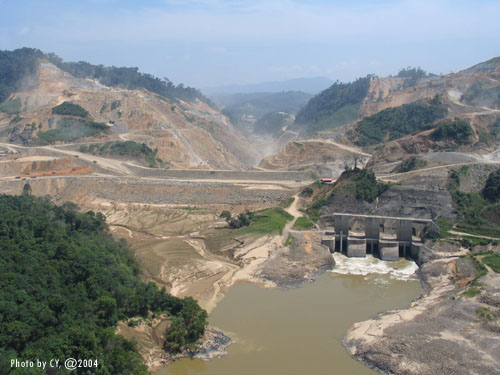Well, I bet almost all of us enjoyed the module very much, right? I do enjoyed the time* spent in the class throughout the semester. English learning has never been this fun and interactive before. The class size is just perfect to carry out all kinds of discussions. Yeah. All kinds. Basically, we can group ourselves into three groups based on our nationality. Three is good enough so that we can stay focused in just three countries when comes to discussion. Well... actually is FOUR. I've forgotten our Sensei. Hey, he himself is a one-man group, representing himself as an American, Russian, Japanese, Malaysian, Singaporean... but what, since he is IN our class, so he should be considered as one of our classmates as well.
(*excluding the time spent in doing the pain-in-the-ass text editing)
Indeed, what have made our classes so fun are actually all the discussion topics.
As you can see from the equation, the interestingness plays an important role. The class itself is just like a closed door discussion that we can discuss all sorts of topics, including those sensitive ones =X Hope that nobody recorded anything from the class.
Here are some of my feelings from the class. Since Malaysia is so good in practicing discrimination, I am going to DISCRIMINATE you all based on your nationality!
The (one and only) American
 "Smoke a cigarette and drink some beer!" Well, I will appreciate that if you practice that in class... Nah, just joking! Thank you for making this class being a so interactive and interesting one. ありがとうございます! Without you, it would not be possible to provide a platform to practice "freedom of speech" in the class. I really appreciate that.
"Smoke a cigarette and drink some beer!" Well, I will appreciate that if you practice that in class... Nah, just joking! Thank you for making this class being a so interactive and interesting one. ありがとうございます! Without you, it would not be possible to provide a platform to practice "freedom of speech" in the class. I really appreciate that.
The Chinese (from China)
 Frankly speaking, you all have changed some of my (not so positive) thoughts towards students who came from China. You all are more friendlier than I thought. Thank you for sharing your experiences and informations from China. I have learnt a lot from them. To Li Hui, Xue Jie, and Guo Cheng, I had a great time mixing with you all as a group. It is also interesting to mix around with the rest of you.
Frankly speaking, you all have changed some of my (not so positive) thoughts towards students who came from China. You all are more friendlier than I thought. Thank you for sharing your experiences and informations from China. I have learnt a lot from them. To Li Hui, Xue Jie, and Guo Cheng, I had a great time mixing with you all as a group. It is also interesting to mix around with the rest of you.
The 'Locals' (Singaporeans)
 Strange but true, the smallest group in class. If any of you ever felt humiliated (the word sounds too serious) because you have failed the QET, think again. Perhaps you are the lucky ones who get the chance to mix with all the classmates and also Sensei. Living 18 years across the Straits of Johor (Malaysians call it Selat Tebrau), I consider myself as a 'half local'. Perhaps my understandings of Singapore might be a little bit better in certain aspects, but you all still, have provided me much insights of Singapore. Nice one!
Strange but true, the smallest group in class. If any of you ever felt humiliated (the word sounds too serious) because you have failed the QET, think again. Perhaps you are the lucky ones who get the chance to mix with all the classmates and also Sensei. Living 18 years across the Straits of Johor (Malaysians call it Selat Tebrau), I consider myself as a 'half local'. Perhaps my understandings of Singapore might be a little bit better in certain aspects, but you all still, have provided me much insights of Singapore. Nice one!
The Malaysians
 I have the most to talk about in this part. Thank you all for making Malaysians proud. We have seen the event, which can change the future of our home, from our neighbor. Channel News Asia does provide better coverage during and after the election than the
I have the most to talk about in this part. Thank you all for making Malaysians proud. We have seen the event, which can change the future of our home, from our neighbor. Channel News Asia does provide better coverage during and after the election than the sum of all mainstream medias in Malaysia. To Uwa: I am glad that the Indians are able to stand up against the discrimination, congratulations. Makkal Sakti! To Saw, don't be afraid of whatsoever Islamic Law to be implemented in the state or the country. PAS had enough of lesson, and it is almost impossible to it without the support of ALL allies. To Johorians, look at the condition in Johor Bahru. It's time to give some chance for opposition in Johor. Recover the balance is the current priority.
The current success in Malaysia's democracy couldn't be achieved without these 'alternative medias'. Here's the list of some important sites:
Okay, enough of politics. Got digressed. Back to EG1471.
So, how about the future of this blog? Actually I haven't decide yet. Maybe I should leave this remained as the EG1471 blog because I really like the "Blogging for EG1471" title and the image. We'll see how it goes!

Finally, I wish that all of us can do our best in our exam!
(*excluding the time spent in doing the pain-in-the-ass text editing)
Indeed, what have made our classes so fun are actually all the discussion topics.
INTERESTING topics + Discussion = lots of talking = fun
As you can see from the equation, the interestingness plays an important role. The class itself is just like a closed door discussion that we can discuss all sorts of topics, including those sensitive ones =X Hope that nobody recorded anything from the class.
Here are some of my feelings from the class. Since Malaysia is so good in practicing discrimination, I am going to DISCRIMINATE you all based on your nationality!
The (one and only) American
 "Smoke a cigarette and drink some beer!" Well, I will appreciate that if you practice that in class... Nah, just joking! Thank you for making this class being a so interactive and interesting one. ありがとうございます! Without you, it would not be possible to provide a platform to practice "freedom of speech" in the class. I really appreciate that.
"Smoke a cigarette and drink some beer!" Well, I will appreciate that if you practice that in class... Nah, just joking! Thank you for making this class being a so interactive and interesting one. ありがとうございます! Without you, it would not be possible to provide a platform to practice "freedom of speech" in the class. I really appreciate that.The Chinese (from China)
 Frankly speaking, you all have changed some of my (not so positive) thoughts towards students who came from China. You all are more friendlier than I thought. Thank you for sharing your experiences and informations from China. I have learnt a lot from them. To Li Hui, Xue Jie, and Guo Cheng, I had a great time mixing with you all as a group. It is also interesting to mix around with the rest of you.
Frankly speaking, you all have changed some of my (not so positive) thoughts towards students who came from China. You all are more friendlier than I thought. Thank you for sharing your experiences and informations from China. I have learnt a lot from them. To Li Hui, Xue Jie, and Guo Cheng, I had a great time mixing with you all as a group. It is also interesting to mix around with the rest of you.The 'Locals' (Singaporeans)
 Strange but true, the smallest group in class. If any of you ever felt humiliated (the word sounds too serious) because you have failed the QET, think again. Perhaps you are the lucky ones who get the chance to mix with all the classmates and also Sensei. Living 18 years across the Straits of Johor (Malaysians call it Selat Tebrau), I consider myself as a 'half local'. Perhaps my understandings of Singapore might be a little bit better in certain aspects, but you all still, have provided me much insights of Singapore. Nice one!
Strange but true, the smallest group in class. If any of you ever felt humiliated (the word sounds too serious) because you have failed the QET, think again. Perhaps you are the lucky ones who get the chance to mix with all the classmates and also Sensei. Living 18 years across the Straits of Johor (Malaysians call it Selat Tebrau), I consider myself as a 'half local'. Perhaps my understandings of Singapore might be a little bit better in certain aspects, but you all still, have provided me much insights of Singapore. Nice one!The Malaysians
 I have the most to talk about in this part. Thank you all for making Malaysians proud. We have seen the event, which can change the future of our home, from our neighbor. Channel News Asia does provide better coverage during and after the election than the
I have the most to talk about in this part. Thank you all for making Malaysians proud. We have seen the event, which can change the future of our home, from our neighbor. Channel News Asia does provide better coverage during and after the election than the The current success in Malaysia's democracy couldn't be achieved without these 'alternative medias'. Here's the list of some important sites:
- Malaysiakini [English] [BM] [中文版] [தமிழ]
- Malaysia Today [The Corridors of Power] [No Holds Barred]
- 独立新闻在线
Okay, enough of politics. Got digressed. Back to EG1471.
So, how about the future of this blog? Actually I haven't decide yet. Maybe I should leave this remained as the EG1471 blog because I really like the "Blogging for EG1471" title and the image. We'll see how it goes!

Finally, I wish that all of us can do our best in our exam!















